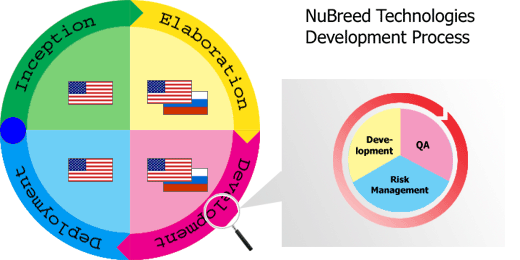
NuBreed Technologies has adopted internationally accepted software development standard called RUP (Rational Unified Process). To minimize the risk of project failures, NuBreed Technologies utilizes an iterative approach to software development through continuous test, build and release process.

Our development process (refer to diagram) consists of the following project phases:
Inception Phase (US)
During the inception phase we will aim to define the system’s boundaries and gather high-level requirements. Our analysts will analyze customer’s request that will be compiled into a project Vision document.
The first version of Software Requirements document will be created and proposed to a client for approval. The analysis of Business Domain will be performed as needed in a project. Then, we will use the acquired data and analysis to generate an early architectural proposal, including the advice on choice of technology and hardware rough project plan estimation.
Elaboration & Design Phase (US)
This phase will consist of a development of architectural baseline for the system. Our system architects will design and test several approaches to determine which one best suit the client needs and system requirements. During this phase the skeleton for the system will be developed and one or more prototypes will be delivered for a client for approval. The project plan will be significantly updated and will include the precise time and cost estimation.
Construction (Mixed)
Based on the project plan, plus the architecture and technology analysis, our team of developers, project managers, testers and graphic designers will craft the products in version increments to allow easy change or modification request incorporation. Each iteration will add certain functionality or feature to the system, so that the client can monitor more efficiently the process of the project. In this phase the emphasis is placed on the Build, Test and Release methodology.
- Development Implementation (Offshore): Our offshore development team receives the project plan and proceeds to build the system as an array of individual components. As a component is completed, the offshore team submits the source to the integration team working at the client site for assembly and testing.
- Quality Assurance (US): The components are assembled at the client site, where they undergo rigorous unit testing. After a successful test, components are then deployed to a test environment where they are system tested and stress tested. If the component does not pass our strict quality controls in the testing phase, the source is resubmitted back to the offshore team for revisions.
- Deployment (US): After a component passes quality controls, it is deployed into the production environment where the end users have the ability to view how the new functionality behaves in the real world.
Transition/Knowledge Transfer (US)
After the successful installation of the system on the production servers we will provide a comprehensive training to the client’s IT/MIS personnel.
Our methodology has a proven track record of saving companies up to 30% to 50% off the development costs.
|